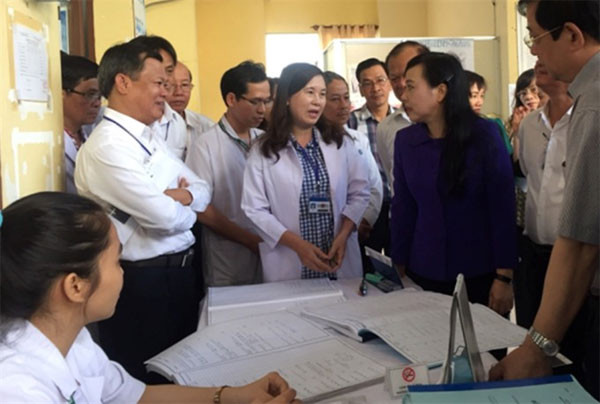 Minister of Health Nguyen Thi Kim Tien visits the Tan Thanh Ward health centre in HCM City’s Tan Phu District, where the family medicine model is being implemented. (Photo: .medinet.hochiminh.gov.vn)
Minister of Health Nguyen Thi Kim Tien visits the Tan Thanh Ward health centre in HCM City’s Tan Phu District, where the family medicine model is being implemented. (Photo: .medinet.hochiminh.gov.vn)HCM City (VNA) - TheMinistry of Health will soon spell out what medicines and medical techniquesshould be used by ward- and commune-level health centres around the country tomake the family medicine model more efficient and reassure patients.
It hopes to adopt the model in 80 percent of provinces and cities.
Minister of Health Nguyen Thi Kim Tien said the adoption of thefamily medicine model could help ensure patients do not go to district or higherlevel hospitals for treatment of minor ailments.
Patients often do this because grassroots-level health facilitiesdo not provide sufficient care.
“If the model is efficient it could help reduce the overcrowdingat high-level health facilities, which also causes a risk of transmission.”
Grassroots health centres will also benefit from the new move.
In HCM City, 191 out of 319 ward- and commune-level health centreshave adopted the family medicine model starting in 2013.
Speaking at a meeting on family medicine in HCM City on March 27,Dr Luu Thi Thanh Huyen, deputy head of the city’s Social Insurance Agency, said70 centres in the city failed to get even one patient last year.
Nguyen Thanh Trang, head of the Tan Binh District’s PreventiveMedicine Centre, which manages the district’s health centres, said 10 of themhad seen the family medicine model fail.
“Patients do not come to these medical facilities for manydifferent reasons, one of them being that patients did come but there was nodoctor to treat them.”
Le Van The, head of the District 1’s Preventive Health Centre,said the family medicine model was adopted at the Co Giang Ward Health Centrein 2013.
“In the beginning the centre attracted a large number of patients,most of them insured, but now few come because insured patients have no coverfor ultrasound and blood tests," he said.
Moreover, "medicines provided at the centre are not similarto the ones provided at district-level hospitals, making patients fear they arenot of good quality," he said.
So insured patients went straight to district-level hospitals, hesaid.
According to Huyen of the city’s Social Insurance Agency, itis not right to say that health insurance does not cover ultrasound and bloodtests at ward- and commune-level health centres.
But the fact is that at several centres, the machines areinstalled by medical equipment suppliers, who share the fees that patients payfor testing, and not the city’s Department of Health, she revealed.
Tien said doctors at district hospitals should provide technicalassistance to ward- and commune-level health centres, like Thu Duc DistrictHospital does.
The hospital’s doctors take turns to work at lower level healthcentres to train and improve their professional skills.
The hospital and these centres share health data of insuredpatients, according to Dr Nguyen Minh Quan, the former’s head.
"Thus, doctors at the hospital know about a patient’s healthstatus when a centre transfers them to the hospital for furthertreatment", he said.
"The hospital has also provided these centres withequipment."
"The latter function as the hospital’s satellite clinics, andattract a large of number of patients," he said.
For instance, the Binh Chieu Ward health centre, which has adoptedthe family medicine model, got around 80 insured patients every day, headded.-VNA




























